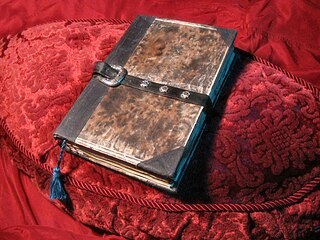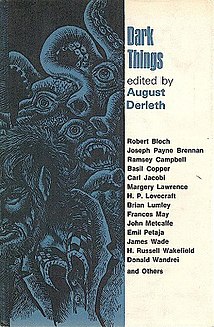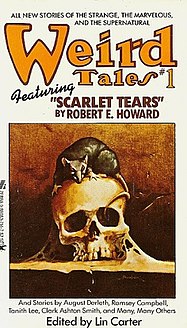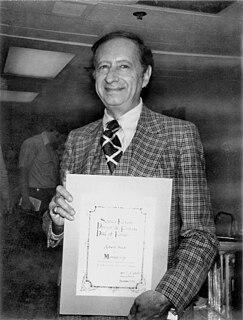
Arkham is a fictional town situated in Massachusetts. It is a dark city and an integral part of the Lovecraft Country setting created by H. P. Lovecraft. It is featured in many of his stories and those of other Cthulhu Mythos writers.
Arkham House is an American publishing house specializing in weird fiction. It was founded in Sauk City, Wisconsin in 1939 by August Derleth and Donald Wandrei to preserve in hardcover the best fiction of H. P. Lovecraft. The company's name is derived from Lovecraft's fictional New England city, Arkham. Arkham House editions are noted for the quality of their printing and binding. The colophon for Arkham House was designed by Frank Utpatel.

Brian Lumley is an English author of horror fiction. He came to prominence in the 1970s writing in the Cthulhu Mythos created by American writer H.P. Lovecraft but featuring the new character Titus Crow, and went on to greater fame in the 1980s with the best-selling Necroscope series, initially centered on character Harry Keogh who can communicate with the spirits of the dead.
The Bram Stoker Award for Short Fiction is an award presented by the Horror Writers Association (HWA) for "superior achievement" in horror writing for short fiction.
The Bram Stoker Award for Best Fiction Collection is an award presented by the Horror Writers Association (HWA) for "superior achievement" in horror writing for best fiction collection.

Weird fiction is a subgenre of speculative fiction originating in the late 19th and early 20th centuries. John Clute defines weird fiction as a "Term used loosely to describe Fantasy, Supernatural Fiction and Horror tales embodying transgressive material". China Miéville defines weird fiction thus: "Weird Fiction is usually, roughly, conceived of as a rather breathless and generically slippery macabre fiction, a dark fantastic often featuring nontraditional alien monsters ." Discussing the "Old Weird Fiction" published in the late 19th and early 20th centuries, Jeffrey Andrew Weinstock says, "Old Weird fiction utilises elements of horror, science fiction and fantasy to showcase the impotence and insignificance of human beings within a much larger universe populated by often malign powers and forces that greatly exceed the human capacities to understand or control them." Weird fiction either eschews or radically reinterprets ghosts, vampires, werewolves, and other traditional antagonists of supernatural horror fiction. Weird fiction is sometimes symbolised by the tentacle, a limb-type absent from most of the monsters of European folklore and gothic fiction, but often attached to the monstrous creatures created by weird fiction writers such as William Hope Hodgson, M. R. James, and H. P. Lovecraft. Weird fiction often attempts to inspire awe as well as fear in response to its fictional creations, causing commentators like Miéville to say that weird fiction evokes a sense of the numinous. Although "weird fiction" has been chiefly used as a historical description for works through the 1930s, the term has also been increasingly used since the 1980s, sometimes to describe slipstream fiction that blends horror, fantasy, and science fiction.
"The Haunter of the Dark" is a horror short story by American author H. P. Lovecraft, written in November 1935 and published in the December 1936 edition of Weird Tales. It was the last-written of the author's known works, and is part of the Cthulhu Mythos. The epigraph to the story is the second stanza of Lovecraft's 1917 poem "Nemesis".

Many fictional works of arcane literature appear in H.P. Lovecraft's cycle of interconnected works often known as the Cthulhu Mythos. The main literary purpose of these works is to explain how characters within the tales come by occult or esoterica. However, in some cases the works themselves serve as an important plot device. Thus, in Robert Bloch's tale "The Shambler from the Stars", a weird fiction writer seals his doom by casting a spell from the arcane book De Vermis Mysteriis.
De Vermis Mysteriis, or Mysteries of the Worm, is a fictional grimoire created by Robert Bloch and incorporated by H. P. Lovecraft into the lore of the Cthulhu Mythos.
The World Horror Convention Grand Master Award is a yearly distinction given to an author who has contributed greatly to the field of horror literature. Nominees must be alive at the time of voting and can not have previously won the award. The award is given at the annual World Horror Convention.
A Cthulhu Mythos anthology is a type of short story collection that contains stories written in or related to the Cthulhu Mythos genre of horror fiction launched by H. P. Lovecraft. Such anthologies have helped to define and popularize the genre.
Necronomicon Press is an American small press publishing house specializing in fiction, poetry and literary criticism relating to the horror and fantasy genres. It is run by Marc A. Michaud.

Dark Things is an anthology of horror stories edited by American writer August Derleth. It was released in 1971 by Arkham House in an edition of 3,051 copies. It was Derleth's fourth anthology of previously unpublished stories released by Arkham House. A translation in Japanese has also been released.

Weird Tales was a series of paperback anthologies, a revival of the classic fantasy and horror magazine of the same title, published by Zebra Books from 1980 to 1983 under the editorship of Lin Carter. It was issued more or less annually, though the first two volumes were issued simultaneously and there was a year’s gap between the third and fourth. It was preceded and succeeded by versions of the title in standard magazine form.
Jill Bauman is an American artist. She has been nominated for the World Fantasy Award five times and nominated for the Chesley Award several times. Her art has been exhibited at the Delaware Art Museum, the Moore College of Art, Art Students League of New York, the NY Illustrators Society & and the Science Fiction Museum of Seattle. Jill Bauman has created hundreds of book covers for horror, mystery, fantasy, science fiction, and best selling books including 23 of the Cat Who… books by Lilian Jackson Braun during the 1980s and 1990s.
Crypt of Cthulhu is an American fanzine devoted to the writings of H. P. Lovecraft and the Cthulhu Mythos. It was published as part of the Esoteric Order of Dagon amateur press association for a short time, and was formally established in 1981 by Robert M. Price, who edited it throughout its subsequent run.







